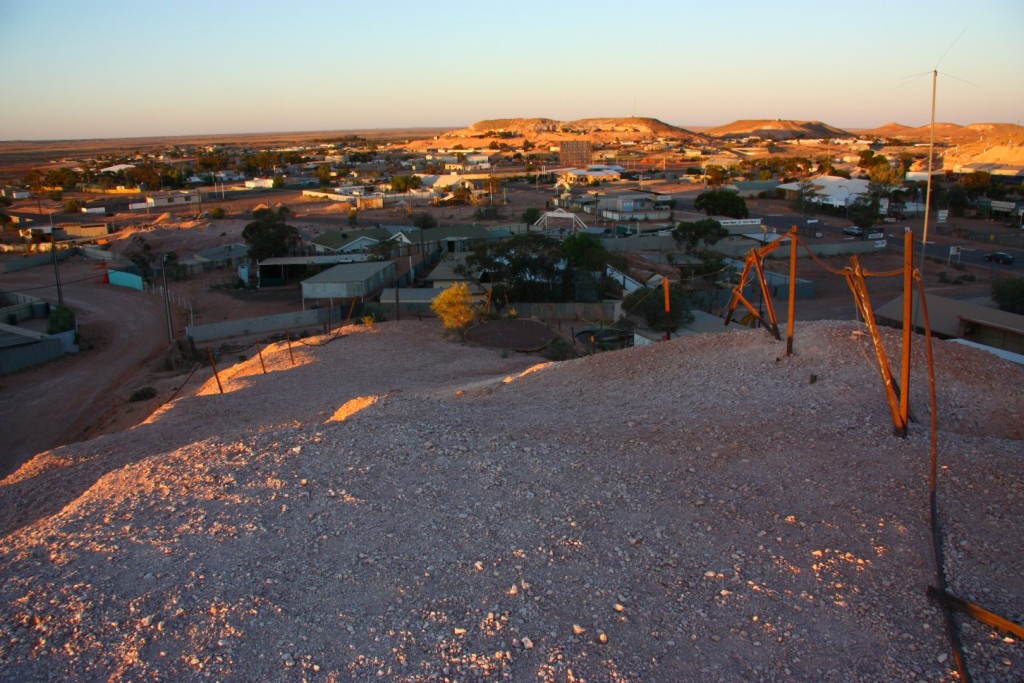I was planning to write an update about Tasmania, Australia’s southernmost island state, about fourteen days of hiking through moss-laden rainforest and along quartzite ridges, about the value of wilderness. But that was before I arrived in Coober Pedy.
“Welcome to Radeka Downunder”, the sign at the hostel reception read. And they meant downUNDER. “6.5 Metres Deep Down Under Ground!” to be precise. This factoid was presented with exclamation points and printed on t-shirts in the hostel gift shop, but I didn’t need to know how Deep Down Under Ground I was. I felt claustrophobic enough descending the stairs and ramps into the catacomb-like sleeping quarters. At first, daylight filtered down from the ground floor, illuminating the questionable interior decorating choice of posters of native snakes and spiders. It grew darker as I reached the bottom; by the time I reached “The Dungeon”, the 21-bed dormitory where I’d be spending the night, I was creeping, feeling my way along earthen walls, eight years old again and afraid of the dark. The dorm was a long, narrow, uneven cave (6.5 Meters Deep Down Under Ground), with bunk beds lining the walls and no door, just an arched opening off the main hall. I found a light switch and a single bulb began to glow from the wall fitting. Shit, I thought, surveying the ghostly line up of beds. It’s going to be DARK in here tonight.”
Coober Pedy is the opal capital of Australia, a sun-baked blip on the Stuart Highway, halfway between Adelaide and Alice Springs. Whitish-pink piles of rock and sand, tailings piles from individual opal mines, spread out from the town in a fragmented web. They look like little white tents on the horizon, like the dwellings of nomadic tribes of moon-people, or mole-people: most of Coober Pedy’s inhabitants live underground. With summer temperatures soaring to 55°C (131°F), Radeka Downunder isn’t a kitschy tourist attraction—it’s a survival tactic.
I arrived in CP at the hottest time of day (43°C (109°F), not bad for February), after eight hours of driving from Adelaide. I caught a lift with Richard, the owner of Trek Tours, which runs guided hikes on the increasingly popular Larapinta Trail in the Western Macdonnell Ranges, north of Alice Springs. Richard was on his way north to prepare for the coming season, and for eight hours we shared guiding stories and tips of the trade, and I picked his brain for local knowledge of Australia’s Red Center. I watched the landscape drop away from my comfortable seat in the air conditioned Land Cruiser. Topography disappeared first. Then trees, then bushes, until our vehicle was the highest point for 360 degrees for hundreds of miles in any direction. Even the horizon became indistinct, seen through thick, wavering mirage. Sun bleached bones and still-decomposing bodies of road-killed kangaroos decorated the narrow, red shoulders. Lizards the size of small cats scuttled to cross ahead of our tires and a wedge-tailed eagle perched on a road sign warning “Drowsy Drivers Die – Next Rest Stop 275 kms”. Road trains, tractor trailer trucks hauling two or three trailers blasted us with loud backwash, and a hot northerly headwind pushed at our vehicle.
After a month of wandering the gentle, green, forested mountains of Victoria and Tasmania, so similar to New Zealand and Chilean Patagonia, I finally felt that I had arrived in Australia. Finally, I felt that addictive traveler’s rush that’s part fear, part lust, and all excitement. Finally, something different.
In Coober Pedy, I treated myself to pizza and a beer (impossible to drink anything but when it’s 43°C in the shade) and climbed onto the “roof” (a two-story dirt pile) of the local opal museum to watch the sun split and bleed into the horizon like a broken egg yolk. Flies hummed in my ears and landed on my face, crawling over my sunglasses, landing on my nose, my cheeks, my lips; I could feel their tiny legs with excruciating clarity as they landed and took off, determined to suck the moisture from my mucous membranes. Below me, Coober Pedy was almost motionless, a ghost town. A few cars passed on the main street. An Aboriginal woman stood at the pay phone, not calling, just waiting. A dark-skinned man with wild white hair and a beard stood on a chair in his barren front yard and peered over the corrugated metal fence into the road. Behind him, a metal-framed bed with tangled sheets and pillow stood under an acacia tree.
Richard picked me up the following morning for the rest of our drive to Alice Springs, the main service town for pretty much all of central Australia. Population 25,000 (ish), it’s less surreal than CP, but it is still far, far out there. I’m set up in a hostel with an underground pool (the hostel is aboveground) and air conditioning, and I’m planning the next adventure, with Richard’s help: five days on that famous Larapinta Trail, five days of stinking, scorching, stupid desert heat—but I’m told there are swimming holes. I’m looking forward to some dawn hiking and day-sleeping, embracing my inner lizard. Viva la novedad!

I remember arriving in Coober Pedy mid-July, 2010. What a surprise! And even more so in Alice Springs and around Uluru… I’m glad I can read you again and enjoy your prose and your wanderlust!
Tell us about that Novedad in Oz!
Happy Trails, dear Susan!
Jul’